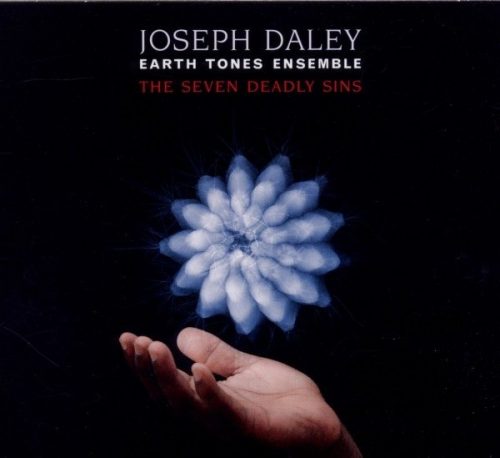The Earth Tones Ensemble is a project-band formed by Joseph Daley of the Hazmat Modine around the concept of using richly-colored earthly sounds as orchestral textures in order to depict the dark and humanly nature of sin. The music is derived from Wade Schuman’s paintings depicting the seven deadly sins.
The resulting band is truly well “grounded”. The tones that dominate its music seem to come from the deepest depth of the earth. In this sense, the key element for the project was to include a large number of instruments in the area of the deepest basses played deliberately in the lowest registers possible. Joseph Daley referred to this concept by stating: “I wanted to make the timbres of the low-pitched instruments the core of my compositions, and wanted the other instruments to be able to rest on those deep tones”. As a result, the listener can feel how the force of gravity gets entangled in the nature of sin.
Joseph Daley is himself a “low brass specialist”. He plays the euphonium, trombone and tuba. He has worked, toured and recorded with many of the members of this ensemble. When he asked them to be part of the unusual Earth Tones Ensemble project, they all agreed. Johnson and Scott Robinson played bass giants rarely seen and heard: contra-bass clarinet, contra-bass saxophone and the bass sarrusophone (a bass instrument developed in the nineteenth century by Frenchman Pierre-Auguste Sarrus and akin to the saxophone). The appearance of these colossi alone is impressive, to say nothing of their sound. Next to them the tuba, euphonium and bass trombone played by Bob Stewart, Joseph Daley and Earl McIntrye seem small. However, it is not only the deep bass instrumentalists that accompany this project. The names of the other musicians – Marty Ehrlich, Lou Soloff, Stanton Davis, Gary Valente, Vincent Chancey, to name just a few reads like a Who’s Who of the American jazz. It really is an illustrious twenty-five member big band aimed at delivering you an unique experience along the record!
It is not accidental at all that The New York City Jazz Record Magazine (January, 2012) listed Joseph Daley and The Earth Tones Ensemble as the best debut and large ensemble release.
Joseph Daley’s Style
In an All About Jazz review, Raul D’Gama Rose compares Joseph Daley’s style to the one of great composers like Ellington, Marsalis and Mingus: “As creator of these magnificent suites, he [Joseph Daley] virtually invites comparisons with others in contemporary music that have written extended works and presented them for broad appreciation. Certainly Daley’s work recalls to mind many of Duke Ellington’s suites and some of Wynton Marsalis’ longer works, such as From the Plantation to the Penitentiary , perhaps even to Charles Mingus’ Epitaph. Daley’s work is more in line with Duke and Mingus, who employed somewhat larger ensembles than Marsalis.”. However, it is not only the composer who dictated the sound of the band. A lot of merit should go to other instrumentalists too. In this way, a review from Jazz Chicago praises the multitude of first-class musicians featured in this project. When referring to his fabulous team, Joseph Daley states: “I wanted to have instrumental voices that are unique, but also characterized by strong spiritual sublimity”. Without exception, they are musicians Daley knows well, musicians whose special style and technique he is familiar with. Joseph Daley was accordingly able to tailor his music to each of them– a circumstance to which every note testifies. Joeseph was interested in them as outstanding musicians, but more importantly “that they’re first-class listeners”, who were able to perceive what’s going on around them and draw musical conclusions from it.
Bruce Lee Gallanter, the Down Town Music Gallery Magazine, concludes about the band’s style that: “The music is warm with well-conceived autumnal colors. The harmonies for the reeds and brass are rich and often breathtaking”.
Joseph Daley– conductor, composer, euphonium, tuba
Marty Ehrlich– soprano saxophone
Jimmy Cozier– alto saxophone
Bill Saxton, Bob DeBellis– tenor saxophone
Howard Johnson– baritone, contrabass clarinet, tuba
Scott Robinson– bass, sarrusophone, Contrabass, Saxophone
Lou Soloff, Stanton Davis, Eddie Allen, Reggie Pittman, Stephen Haynes– trumpet
Gary Valente, Alfred Patterson, Craig Harris– trombone
Earl McIntyre– bass trombone, tuba
Bob Stewart– tuba
Vincent Chancey, Mark Taylor– French horns
Onaje Allan Gumbs– piano
Benjamin Brown– contrabass, electric bass, tuba
Warren Smith– vibraphone, marimba, percussion
Buddy Williams– drum set, percussion
Satoshi Takeishi– Asian drum set, percussion
William Bausch– timbales, percussion
Richard Huntley– percussion

